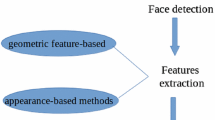Abstract
Despite significant amount of research on automatic classification of facial expressions, recognizing a facial expression remains a complex task to be achieved by a computer vision system. Our approach is based on a close look at the mechanisms of the human visual system, the best automatic facial expression recognition system yet. The proposed model is made for the classification of the six basic facial expressions plus Neutral on static frames based on the permanent facial features deformations using the Transferable Belief Model. The aim of the proposed work is to understand how the model behaves in the same experimental conditions as the human observer, to compare their results and to identify the missing informations so as to enhance the model performances. To do this we have given our TBM based model the ability to deal with partially occluded stimuli and have compared the behavior of this model with that of humans in a recent experiment, in which human participants had to classify the studied expressions that were randomly sampled using Gaussian apertures. Simulations show first the suitability of the TBM to deal with partially occluded facial parts and its ability to optimize the available information to take the best possible decision. Second they show the similarities of the human and model observers performances. Finally, we reveal important differences between the use of facial information in the human and model observers, which open promising perspectives for future developments of automatic systems.
Preview
Unable to display preview. Download preview PDF.
Similar content being viewed by others
References
Darwin, C.: The expression of the emotions in man and animals. London, Murray (1872)
Ekman, P., Friesen, W.V., Ellsworth, P.: Emotion in the human face. Pergamon Press, New York (1972)
Izard, C.: The face of emotion. Appleton-Century-Crofts New York (1971)
Pantic, M., Rothkrantz, L.: Automatic analysis of facial expressions: The state of the art. IEEE Transactions On Pattern Analysis and Machine Intelligence 22(12), 1424–1445 (2000)
Gao, Y., Leung, M., Hui, S., Tananda, M.: Facial expression recognition from line-based caricatures. IEEE Transaction on System, Man and Cybernetics - PART A: System and Humans 33(3) (2003)
Abboud, B., Davoine, F., Dang, M.: Facial expression recognition and synthesis based on appearance model. Signal Processing: Image Communication 19(8), 723–740 (2004)
Cohen, I., Cozman, F., Sebe, N., Cirelo, M., Huang, T.: Learning bayesian network classifiers for facial expression recognition using both labeled and unlabeled data. Proc. IEEE Computer Vision and Pattern Recognition (2003)
Hammal, Z., Couvreur, L., Caplier, A., Rombaut, M.: Facial expressions classification: A new approach based on transferable belief model. International Journal of Approximate Reasoning (2007), doi: 10.1016/j.ijar.2007.02.003
Smith, M., Cottrell, G., Gosselin, F., Schyns, P.: Transmitting and decoding facial expressions of emotions. Psychological Science 16, 184–189 (2005)
Gosselin, F., Schyns, P.: Bubbles: A technique to reveal the use of information in recognition. Vision Research 41, 2261–2271 (2001)
Smets, P.: Data fusion in the transferable belief model. In: Proc. of International Conference on Information Fusion, Paris, France, pp. 21–33 (2000)
Smets, P., Kruse, R.: The transferable belief model. Artificial Intelligence 66, 191–234 (1994)
Smets, P.: Decision making in the tbm: the necessity of the pignistic transformation. International Journal of Approximate Reasoning 38, 133–147 (2005)
Author information
Authors and Affiliations
Editor information
Rights and permissions
Copyright information
© 2007 Springer-Verlag Berlin Heidelberg
About this paper
Cite this paper
Hammal, Z., Arguin, M., Gosselin, F. (2007). Comparing a Transferable Belief Model Capable of Recognizing Facial Expressions with the Latest Human Data. In: Bebis, G., et al. Advances in Visual Computing. ISVC 2007. Lecture Notes in Computer Science, vol 4841. Springer, Berlin, Heidelberg. https://doi.org/10.1007/978-3-540-76858-6_50
Download citation
DOI: https://doi.org/10.1007/978-3-540-76858-6_50
Publisher Name: Springer, Berlin, Heidelberg
Print ISBN: 978-3-540-76857-9
Online ISBN: 978-3-540-76858-6
eBook Packages: Computer ScienceComputer Science (R0)




